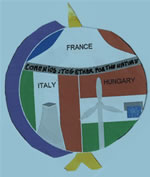Wind power:
The demand for wind energy is increasing all over the world. Every single country wants to suppress their emission factor that is bound up with global warming. The nations’ environment policy urges to use more and more renewable energy resources. It is obvious that we must use these energy resources. The achieved results in the utilisation of wind power are remarkable. There is a considerable reduction in the harmful emission above the cities and this is only one example.
The wind and its origin:
The wind is not else than the flow of the air. It is generated by different atmospheric pressures. Earth is unevenly heated by the sun because of the rotation of our planet. The equator and the surrounding area receives more energy than the poles and in the same way the land heats up and cools down more quickly than the oceans and seas. Warm air over the land expands and rises and the heavier, cooler air rushes to take over the warm air’s place.
The wind power:
Wind power is the conversion of wind energy into useful form. 1-3% of the energy of the Sun turns into wind power on Earth. This is 50-100 times more than the energy that is produced by photosynthesis of the flora of Earth. Most of the wind power can be found at high altitudes where the wind speeds over 160 km/h. At this altitude the wind energy simply disperses, disappears. Close to the ground however, the kinetic energy of the wind can be converted either into mechanical energy or electricity.
The benefits of wind power plants:
Wind farms are one of the most cleanest and harmless establishments and use the plentiful energy of the wind directly to do work or to produce electricity. There is no toxic or radioactive waste during its operation and the chance for a disaster is basically zero. It also reduces greenhouse gas emission and it is a cost-effective investment since the expenses of their construction could return within 2 years. The installation of a wind turbine is relatively quick.
Installation of wind power plant:
It is a difficult task to determine the location and type of a wind farm since the average values of the meteorological stations are sufficient to set up general trends but it is not enough to design the equipment itself.
Since the wind’s speed and strength is always changing, collecting and analyzing data on the spot is very important. You may think that the measurements previous to building a wind power plant focus only to the direction and strength of the wind.
However, the wind’s movement is affected by several other factors:
-changing of the seasons and the alternation of the days and nights
-the lie of the land
-landmarks
-percentage of moisture
The data recorded by the research describe the characteristics of the wind but you have to use statistic procedures to analyse all these information. After all you have sufficient information not only to design but to operate your wind farm as well.
Wind power plants in the European Union:
Favourable features like environmental friendliness and cost effectiveness make the production of wind power grow rapidly all over the world, especially in Europe. Wind turbines produced 74223 megawatt energy throughout the world in 2006 that is still less then 1% of world-wide electricity requirement. Either the produced wind energy or the establishment of the wind turbine is subsidized in any country.
Every country in the EU uses all effort to make the wind power popular and its establishment easier in spite of the fact that more and more energy is produced by wind farms. Germany ranks number one in the world in wind power capacity but Denmark is the head of the utilisation. There had been hardly any wind farm in Denmark before the development of internal combustion engines but after that the production of wind power grew by leaps and bounds.
Wind turbines and wind farms in Hungary:
Countries in Eastern Europe have a lot to do to close up to Germany and Denmark in the utilisation of wind power but a strong growth must come. There has not been any wind farm in Slovenia until 2006 at all. 3 megawatts in Romania, 5 MW in Slovakia, 50 MW in Czech Republic and 61 megawatts in Hungary were the production in the same year. From the surrounding countries Poland’s production is more than ours by 153 MW and similarly Ukraine has 85,5 extra MW.
In order to a wind turbine to work efficiently the annual average wind speed must be above 4-5 m/s. Good sites for wind plants are seashores. As you are getting more and more away from the coast the wind loses its power because of the skin friction. So Hungary is a calm place although a sudden summer storm tries to disprove it from time to time. Wind blows at Budapest by an average of 1,8 m/s but it is even less than 5 m/s at Mosonmagyaróvár that is the most open part of the country. The wind speeds at Nyíregyháza by 4-5 m/s and sometimes even more but it is not persistent enough to be worth to establish a wind plant.
The six most important wind power plants in Hungary are: Inota, Kulcs, and four at Mosonmagyaróvár. With their help Hungary ranks number 32 in the world in wind power capacity.
Interest:
The "Castle House" is a 43-story building in South London. It’s 147m high and has three 9m diameter wind turbines on its top. It will be completed for 2009. The three turbines will supply the whole building’s energy requirements.


